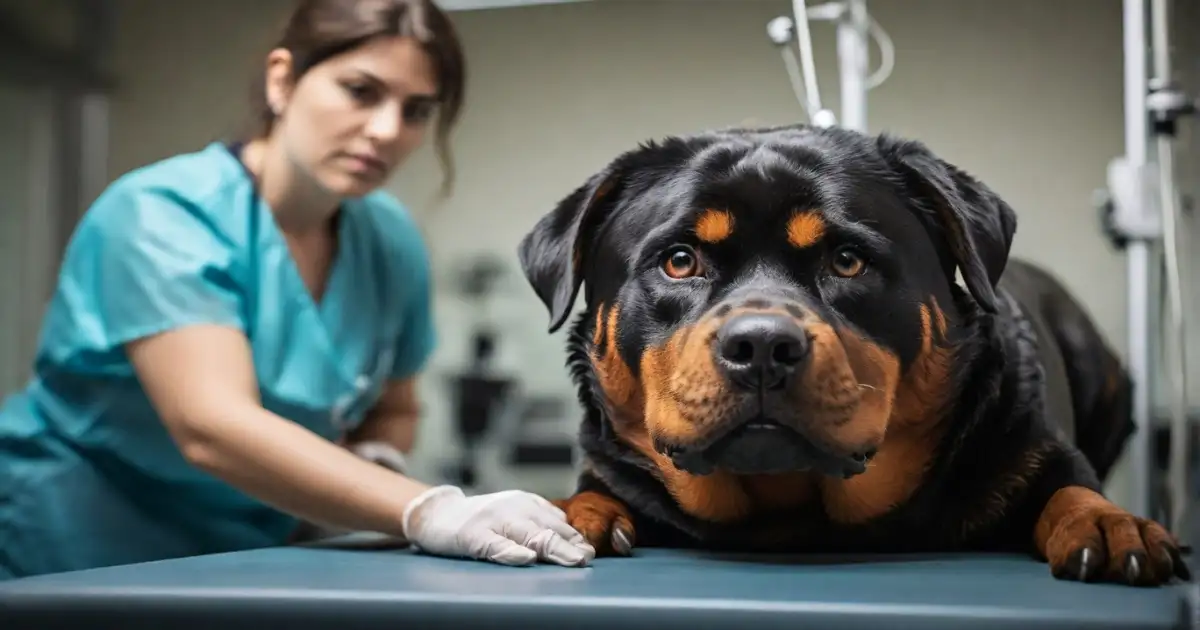Well-cropped ears Rottweilers certainly have a distinctive look, but how did this style originate and is it truly the best choice for the breed?
This post will uncover the aesthetic aspects and responsible practices regarding cropped ears of Rottweilers. From the procedure to its ethics, we’ll explore the key considerations for Rottie owners.
No doubt these powerful pups look gorgeous either way, but perhaps there’s more to those floppy natural ears than meets the eye. So, let’s dive in and decide what’s best for the breed we love!
The Aesthetic Aspects of Cropped Ears Rottweilers
The signature look of a Rottweiler with cropped ears is undoubtedly eye-catching. When done properly, cropping results in very upright, sharply angled triangular ears that enhance the blocky shape of the Rottweiler’s head.
This style has been the breed standard for show and working Rottweilers for over a century. Crop advocates argue this ear style better showcases and accentuates the natural proportions of the Rottweiler skull.
The tall, erect ears draw attention upward, making the head seem wider and more imposing. Cropped ears are also thought to improve hearing by allowing sound to reach the ear canals more easily.
For many, cropped ears are an iconic part of the Rottweiler image. The alert, focused expression contributes to perceptions of Rottweilers as intimidating guard dogs.
Some also find the cropped look adds an air of toughness and masculinity. However, others consider natural, unaltered ears to appear more amicable and approachable.
Aesthetic impressions go both ways – some see cropped ears as a stylish, elegant choice befitting the breed’s refined nature, while others feel natural dogs have a happier, friendlier look. There’s an argument about whether cropping detracts from or enhances the Rottweiler’s inherent beauty.
Trends and perceptions evolve. While cropped ears were once ubiquitous in the show ring and working circles, many modern Rottweiler fanciers embrace the natural look. This shift reflects changing attitudes about cosmetic alterations necessary to meet breed standards.
No matter your aesthetic preference, there’s no denying well-bred Rottweilers are striking dogs in form and temperament. Ear style is a personal choice, but it’s just one aspect of this multifaceted breed.
Perhaps the most important qualities to prioritize are health, soundness and temperament rather than simply judging on looks alone. A great companion, Rottweiler can have natural ears and still epitomize the essence of this dynamic breed.
The Medical Procedure of Cropping a Rottweiler’s Ears
For those who choose to crop their Rottweiler’s ears, it’s important to understand the details of this elective procedure. Ear cropping is usually done when a Rottweiler puppy is 8-12 weeks old.
This age must perform the surgery for the ears to stand correctly as the puppy develops. The procedure is carried out under general anesthesia by a veterinarian.
The portion of the ear to be removed is calculated using measurements, then the ear is cut and shaped into the desired style, usually a triangular upright shape. The vet will then bandage and tape the ears to help them stand erect as they heal.
Pain management medication is administered during and after surgery to keep the puppy comfortable. However, there is still short-term pain while the ears heal, which takes several weeks. Puppies will often shake their heads or rub their ears frequently during this period.
There are risks associated with cropping that owners must consider. As with any surgery requiring anesthesia, there is potential for complications from reactions to the anesthesia itself.
The ears are also susceptible to infections, hematomas, and other issues which may require further treatment. Extensive aftercare is required during the healing process to prevent any problems.
Once healed, the ears need to be taped and posted for several months while the cartilage firms up to ensure they stand properly. Appropriate taping techniques must be followed to avoid damaging the cropped ears. Owners can expect the entire cropping and posting process to take 4-6 months from start to finish.
Some vets may refuse to crop ears based on ethical grounds, so owners seek out those who specialize in cropping. There is controversy around whether cropping should be considered an unnecessary cosmetic procedure versus an appropriate surgical alteration.
Laws differ regionally regarding ear cropping – it is legal in most of the United States but banned in many European countries. In summary, cropping is a complex procedure requiring expert veterinary care, anesthesia, extensive aftercare, and a significant commitment from the owner.
The risks and required effort should be carefully weighed when evaluating if it is appropriate for each Rottweiler.
Ethical Considerations Around Cropping a Rottweiler’s Ears
Ear cropping is undoubtedly done primarily for aesthetic reasons in Rottweilers. But are there ethical concerns around putting puppies through elective surgery solely for appearance? It’s a controversial topic with passionate viewpoints on both sides.
Opponents view cropping as an unnecessary medical procedure since it provides no health benefits to the dog. Putting a young puppy under anesthesia and cutting its ears solely for looks raises questions about ethics and canine welfare. The surgery causes pain and injury that seems only to serve humans’ desires for a certain look.
Additionally, cropping fundamentally alters the natural state of a dog’s body. Those against cropping argue we should accept dogs as they are born, with natural uncropped ears being the healthiest state for the animal.
Surgically modifying their appearance for human preference can be seen as a form of denying dogs their innate physical autonomy. Advocates counter that cropping is no more unethical than spaying or neutering, which is widely accepted and expected in pet dogs.
As with any elective surgery, cropping does not have to be inhumane if properly performed under anesthesia by a qualified veterinarian with appropriate aftercare. They argue minor cosmetic changes do not equate to cruelty or mistreatment if the dog’s overall well-being is prioritized.
Some suggest cropping improves health by reducing ear infections and trauma. However, research has not conclusively proven cropping provides health benefits over natural ears. Laws and attitudes regarding cropping vary greatly around the world. It is typically regulated as an elective cosmetic surgery that veterinarians can choose to provide.
But ear cropping is outright banned in many European countries and Australia, where it is deemed an unnecessary mutilation. Other places like New York City have proposed bans on cropping dogs. At the end of the day, there are reasonable points to consider on both sides of this complex issue.
As a Rottweiler owner, being fully informed allows one to make the most responsible choice for each dog. An open-minded, serious debate is needed to achieve the best ethical practices. Perhaps a balanced compromise moving forward is to retain cropping as a personal choice and accept natural-eared Rottweilers as equally valued representations of the breed.
There is no definitive right or wrong answer for all dogs and owners. Continuing thoughtful discussion of Cropping’s complex ethics will serve Rottweiler’s well-being as understanding evolves.
Responsible Choices for Cropped Ears Rottweilers Owners
Regarding cropped ears Rottweilers, owners have an important decision to make. While the distinctive look appeals to some, prioritizing the dog’s health and welfare should be the top priority. Making informed, responsible choices is key.
Considering the Dog’s Needs First
First and foremost, what is best for the individual Rottweiler’s well-being should drive choices around cropping. The most responsible path for owners is likely leaving ears natural to avoid any unnecessary procedures or pain.
Rottweilers’ temperament and trainability are much more vital to nurture than specific physical features. An outstanding companion can have natural ears. Seeking a vet who advocates for the dog’s needs over human preferences is also wise.
Focusing on Health, Training and Socialization
Instead of cropping, devote time and resources to raising a healthy, well-adjusted cropped ears Rottweiler. Veterinary care, nutrition, exercise, socialization and training build an exceptional dog.
Invest in puppy classes, obedience courses and activities like agility that stimulate your Rottweiler mentally and physically. Set your dog up for success by teaching good manners and behaviors from a young age.
Being an Advocate for the Breed
Rottweiler owners must make ethical, informed choices as ambassadors for this often misunderstood breed. Set a high standard by prioritizing your dog’s welfare and being a voice for responsible practices.
Educate anyone interested in the breed on the realities of proper Rottweiler ownership. Recommend health testing breeders who leave puppies natural. Steer newcomers away from unsafe fads and myths.
Understanding the Bigger Picture
Look beyond cropping as an isolated choice. How we perceive altering dogs for our own satisfaction versus valuing their innate selves is part of a larger discussion.
Rethink antiquated traditions that originated before we fully recognized dogs as sentient beings. As our understanding of canine psychology and awareness evolves, re-evaluating past practices through a modern lens allows for better aligning traditions with ethics.
Making the Best Choice for Each Dog
The most responsible course around cropping is letting each dog’s needs guide decisions. While there’s no universally right choice for the breed, carefully weigh what will improve your Rottweiler’s health, comfort and quality of life.
Prioritize your companion’s welfare above aesthetics. For most dogs, natural ears are in a healthier state. But cropping is a personal decision for dogs and owners with unique circumstances and preferences. Thoughtfully reflect on what fits your Rottweiler best.
Conclusion on Cropped Ears Rottweilers
The uniquely cropped ear style represents generations of Rottweiler tradition, but thoughtful owners today also consider what’s truly best for the breed going forward.
Reflecting on Key Considerations
When exploring all facets of cropped ears Rottweilers, there are several important points to reflect on:
- Cropping carries short and long-term pain, risks and intensive aftercare
- Natural ears avoid unnecessary procedures and are healthier for most dogs
- Ethics are debatable – cosmetic change or acceptable custom?
- Attitudes have shifted as understanding of canine welfare evolves
- Individual dog’s needs should drive choices more than aesthetics or tradition
The Value of Natural Ears
Upon consideration, natural ears have strong merits for companion Rottweilers. They require no alterations to the dog’s innate state. Floppy ears can still easily showcase the handsome Rottweiler head and expression.
Preserving natural ears skips unnecessary anesthesia and recovery. Natural ears are likely the most responsible choice for owners valuing ethics with a modern perspective on canine welfare.
Committing to the Breed’s Wellbeing
At the heart of this issue is making choices to improve cropped ears in Rottweiler’s lives. Responsible owners accept the breed they love as-is or thoughtfully consider any alterations. They invest in health, training and responsible breeding.
By making choices based on continuous advancement of the breed rather than rigid tradition, Rottweiler aficionados guarantee a bright future for these awe-inspiring dogs.
Embracing the Whole Rottweiler
A great Rottweiler has so much more to offer than ear style alone. Courageous spirit, unwavering loyalty, high intelligence and strength of body and mind make them exceptional.
Honor the breed by embracing all cropped or natural Rottweilers as equals. Let their actions prove these noble dogs shine from within, not just by appearance. Rottweiler lovers staying open-minded will surely further the breed’s legacy.
Frequently Asked Questions
Do Rottweilers have cropped ears?
- Some Rottweilers have cropped ears, while others have natural, uncropped ears. Traditionally, cropping was done to meet the breed standard for shows and working roles. Now it is an elective cosmetic procedure some owners choose to do.
Do Rottweilers get their ears cropped?
- Yes, some Rottweiler owners elect to surgically crop their dogs’ ears to achieve the upright, pointy look considered desirable by some. It is not medically necessary but done for aesthetic reasons.
Why do some dog breeds have cropped ears?
- For some breeds like Dobermans and Great Danes, cropping started as a functional alteration but became an expected look over time. Now, it continues mainly for aesthetic purposes to meet breed standards.
Which dog breeds have cropped ears?
- Common breeds with traditionally cropped ears include Doberman Pinschers, Miniature Pinschers, Schnauzers, Great Danes, Boxers, Boston Terriers, and Rottweilers.
Why do they crop Rottweilers’ ears?
- For Rottweilers, cropping was thought to reduce ear injuries while working. Now it is primarily done for cosmetic purposes to achieve upright, pointy ears to meet the breed standard in shows.
Why do people cut Rottweilers’ tails and ears?
- Docking tails and cropping ears were historically done for functional reasons in working dogs. Today it continues for largely cosmetic reasons to align with breed standards and desired appearance.
Why do people tape Rottweiler ears?
- Taping and posting the ears helps train them to stand upright as desired after cropping surgery. The tapes support the ears in the proper position while the cartilage firms up as they heal.
What states is it illegal to crop dogs’ ears?
- Ear cropping is illegal in many European countries and parts of Australia. In the United States, New York, Maryland, and some cities have proposed bans, but most states still allow it.








